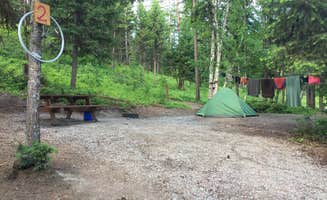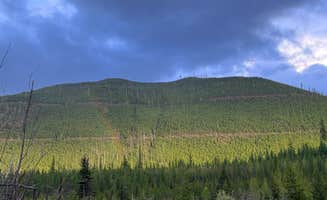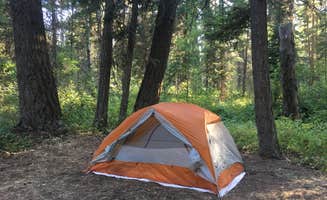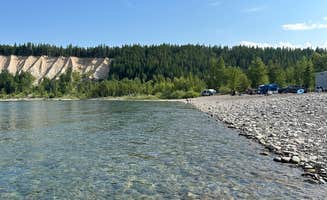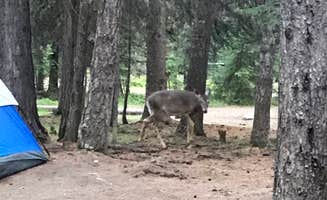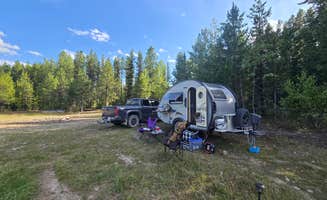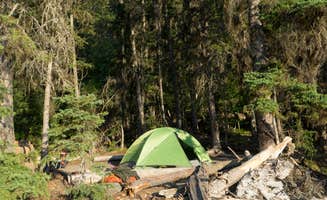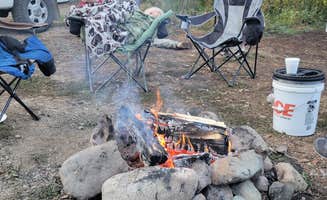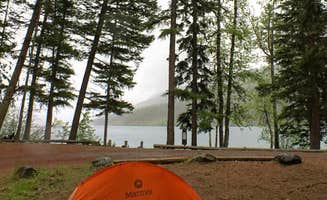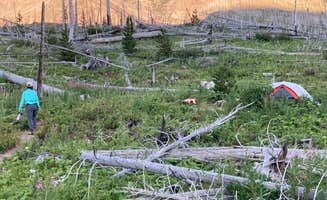Tent camping near Olney, Montana provides access to Glacier National Park's western side, with elevations ranging from 3,000 to 7,000 feet throughout the region. Summer temperatures average 70-80°F during the day but drop to 40-50°F at night, making proper gear essential. The area features dense pine forests with occasional openings that provide mountain views and access to crystalline lakes.
What to do
Paddle sports on calm waters: At Kintla Lake Campground, visitors can enjoy peaceful non-motorized boating. "This part of the lake also does not allow motorized boats so kayaking and canoeing is very pleasant," notes a camper. The clear waters make for excellent paddling conditions.
Biking on nearby trails: Cyclists can access numerous trail systems around the Olney area. At Whitefish Bike Retreat, "There's a large lodge for people wanting a roof over their heads. As another example, if you bike in, they would usually try to make space for you (even if everything was full) and charge $15."
Fishing opportunities: The lakes and rivers offer good trout fishing spots. "We fished here and within 30 seconds of dropping my line I caught my first lake trout! Can't beat that!" reports a visitor to Kintla Lake. Most fishing spots are accessible with a short walk from campsites.
Wildlife viewing: The Olney area provides chances to observe deer, birds, and occasionally bears at a safe distance. Bring binoculars and maintain proper wildlife safety protocols, especially at dawn and dusk when animals are most active.
What campers like
Lake access and water clarity: Campers consistently mention the exceptional water quality. A visitor to Ashley Lake South Campground noted, "The lake is crystal clear and the campground is very clean." The clarity makes swimming and paddling more enjoyable.
Quiet camping atmosphere: Most sites offer a peaceful experience away from crowds. "There are only about 8 sites here, several miles down the road from the Glacier ranger station. It's quiet, all you can hear is the creek and the wind in the trees," explains a camper at Quartz Creek Campground.
Natural surroundings: The forested settings provide shade and privacy. "Sites 4 and 5 are the best as they are right on the creek with water access," reports a camper, highlighting the importance of site selection for the best experience.
Morning views: Early risers are rewarded with misty lake views. "I got up one morning earlier than everyone else, and took the kayak on the water. The sunset was beautiful, and the lake was so calm and relaxing," shares a visitor.
What you should know
Road conditions vary significantly: Many campgrounds require navigating rough roads. A visitor to Blankenship Bridge reports, "The road coming down to the camping area was sketchy with deep potholes and ruts but we had a large SUV so we managed." Prepare for challenging access.
Limited amenities at most sites: Bring all necessary supplies. "There is one central bear box, one central water pump (currently NO water), and one clean vault toilet," explains a camper at Quartz Creek Campground. Water availability changes seasonally.
Weather preparation is essential: Temperature swings of 30-40 degrees between day and night are common in summer. Pack extra layers, rain gear, and appropriate sleeping bags rated for temperatures below what you expect.
Campground availability: Many sites fill quickly during peak season. "There are only about 6-7 spots, first come first serve," notes a camper at Ashley Lake South. Weekday arrivals improve your chances of finding available sites.
Tips for camping with families
Child-friendly activities: Some campgrounds offer recreational opportunities beyond hiking. At Stillwater Getaway, "Ryan was super friendly and offered showers, an outdoor kitchen, kayaks to use, and potable water," providing amenities that help with family camping.
Site selection for safety: Choose campsites away from water edges with young children. At most campgrounds, sites farther from water features offer more contained spaces for families with small children.
Wildlife education opportunities: Use the camping experience to teach children about nature and wildlife safety. Respect wildlife boundaries and never approach or feed animals, even seemingly harmless ones like deer.
Noise considerations: Campgrounds vary in noise levels. A camper at Ryan Road Dispersed Camping observed, "It was fairly quiet on a Monday but there is a train that runs through in the distance and blows the whistle." Consider noise-sensitive children when selecting sites.
Tips from RVers
Size limitations are real: Many forest roads restrict larger vehicles. At Ryan Road, a camper reports, "The road in was narrow. Glad I didn't have any problems with on coming riggs." Most dispersed sites accommodate smaller RVs better than large ones.
Limited hookups available: Plan for self-contained camping. "We stayed for two nights to ride the downhill park but wish we chose something closer with hooks ups. There was some cover but it was hot when the sun was shining," shares an RV camper at Whitefish Bike Retreat.
Turnaround space: Check reports on turning radius before attempting narrow roads. At Ryan Road, "There is a private gated drive at the end (there is a spot to turn around at the last campsite)," notes a visitor, which is crucial information for RVers.
Generator regulations: Rules vary by campground. "We were asked to turn our generator off by our neighbors but were told it can be ran during daylight hours from staff," reports an RVer, highlighting the importance of knowing each site's policies.


